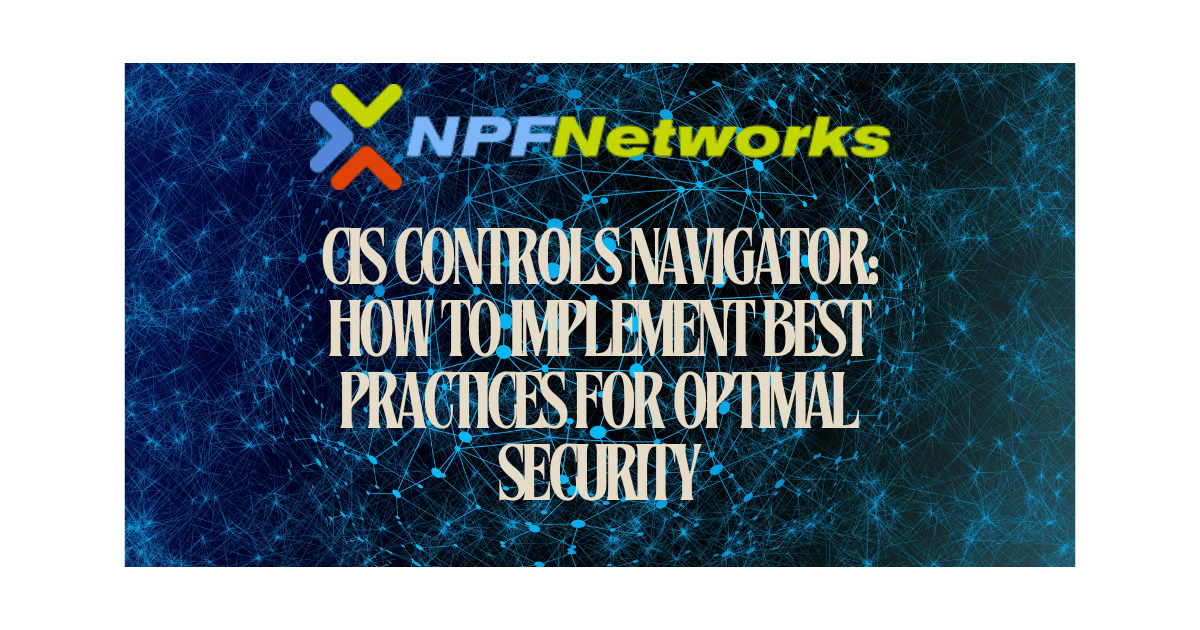In today’s evolving cybersecurity landscape, safeguarding your organization’s network and data has never been more crucial. Cyber threats are becoming increasingly sophisticated, and businesses of all sizes are vulnerable to attacks. To combat these threats, the CIS Controls (Center for Internet Security Controls) provide a trusted, widely-recognized framework that outlines best practices for securing systems and data. At NPF Networks, we understand the importance of adopting these controls to protect your business and maintain optimal security.
In this blog, we’ll walk you through the CIS Controls Navigator and explain how to implement best practices using these controls to enhance your security posture.
What are CIS Controls?
CIS Controls are a set of cybersecurity best practices designed to help organizations protect themselves from the most common and dangerous cyber threats. They are divided into three implementation groups (IG1, IG2, and IG3) based on an organization’s size, type, and security needs. By following the CIS Controls, companies can significantly reduce their risk of a breach or attack.
Why Use the CIS Controls Navigator?
The CIS Controls Navigator is a powerful, free tool that makes it easier to implement and manage the CIS Controls framework. It provides a user-friendly dashboard to track your progress and ensures you’re staying on top of your cybersecurity efforts.
With the CIS Controls Navigator, you can:
- Evaluate your current security posture
- Identify areas of improvement
- Prioritize which controls to implement first
- Track progress toward full implementation
- Align with industry-standard best practices
Steps to Implement Best Practices Using CIS Controls
1. Assess Your Current Security Posture
Before you start implementing any controls, assess your organization’s current security posture. This includes identifying the systems and data you need to protect and understanding your existing vulnerabilities. Using the CIS Controls Navigator, you can input this data and receive tailored recommendations on which controls to prioritize based on your organization’s unique needs.
2. Start with IG1 Controls
If your organization is new to cybersecurity frameworks, begin with the Implementation Group 1 (IG1) controls. These are the basic cyber hygiene practices that every business should follow, such as:
- Inventory and Control of Hardware Assets
- Inventory and Control of Software Assets
- Continuous Vulnerability Management
These controls focus on reducing common attack surfaces and ensuring that the most critical systems are protected.
3. Move to IG2 and IG3 for Advanced Security
Once you’ve implemented IG1 controls, you can move on to more advanced controls in IG2 and IG3. These groups include practices like:
- Secure Configuration of Network Devices
- Data Recovery and Backup Procedures
- Incident Response Management
These steps focus on refining and strengthening your security posture for more sophisticated threats.
4. Track and Adapt Your Strategy
Cybersecurity is not a one-time process but an ongoing effort. Use the CIS Controls Navigator to regularly review your progress and adapt your strategy as needed. As new threats emerge and your business grows, your security needs will evolve. Continuously updating your cybersecurity practices ensures that you’re always protected.
5. Engage Expert Support
If you’re feeling overwhelmed by the CIS Controls or unsure of how to implement them effectively, consider partnering with a managed service provider like NPF Networks. Our team of cybersecurity experts can guide you through the process, ensuring that your organization is fully protected.
Benefits of Implementing CIS Controls
By following CIS Controls, your organization can enjoy several key benefits, including:
- Reduced Risk of Cyber Attacks: Implementing these controls can significantly reduce your vulnerability to cyber threats.
- Compliance with Industry Standards: Many industries require companies to adhere to specific cybersecurity frameworks, and the CIS Controls are widely recognized as a trusted standard.
- Improved Incident Response: With the proper controls in place, your organization can quickly identify, respond to, and recover from security incidents.
Navigating the CIS Controls can seem daunting, but with the CIS Controls Navigator and expert support from NPF Networks, you can streamline the process and ensure your business is protected from modern cyber threats. Implementing best practices not only helps secure your systems but also positions your organization for long-term success in today’s digital world.
Ready to start your cybersecurity journey? Contact NPF Networks today to learn more about how we can help you implement the CIS Controls and safeguard your organization.







Leave a Reply